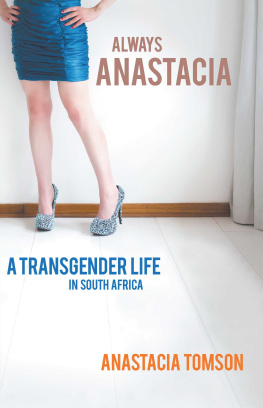Published in 1998 by
Routledge
270 Madison Ave,
New York NY 10016
Published in Great Britain in 1998 by
Routledge
2 Park Square, Milton Park,
Abingdon, Oxon, OX14 4RN
Transferred to Digital Printing 2009
Copyright 1998 by Routledge
All rights reserved. No part of this book may be reprinted or reproduced or utilized in any form or by any electronic, mechanical, or other means, now known or hereafter invented, including photocopying and recording, or in any information storage or retrieval system without permission in writing from the publishers.
Library of Congress Cataloging-in-Publication Data
Burdick, John, 1959
Blessed Anastcia : women, race and Christianity in Brazil / by John Burdick.
P. cm.
Includes bibliographical references and index.
ISBN 0-415-91259-8 (hc.). ISBN 0-415-91260-1 (pbk.)
1. Women, BlackBrazilReligious life. 2. BrazilReligious life and customs. 3. RaceReligious aspectsChristianity. 4. BrazilRace relations. 5. BrazilPolitics and government1985 6. BrazilSocial
conditions-1985 I. Title
BR675.B87 1998
306.6781082908996dc21
9816293
CIP rev.
Publishers Note
The publisher has gone to great lengths to ensure the quality of this reprint but points out that some imperfections in the o riginal may be apparent.
Contents
The Everyday Wounds of Color
Negrasin Love, Family, and Work
Spirited Languages
The Field of Popular Christianity in Rio de Janeiro
The Politics of Mystical Substance
Black Women and the Catholic Inculturated Mass
What is the Color of the Holy Spirit?
Racial/Color Meanings in Pentecostalism
The Eyes of Anastacia
Political Readings of a Popular Catholic Devotion
The Politics of Ethnography
Translating Knowledge Claims into Practice
Conclusion
An Agenda for the Ethnography of Social Movements
Preface and Acknowledgments
In the early 1980s I was active in the solidarity movement with Latin American revolutions. It was an exciting period. Fighting against tremendous odds, the social revolutions of the region embodied, for me and many of my generation, the best and brightest hope for freedom and democracy in the Southern Hemisphere. The role of the Catholic Church in this process seemed fundamental. When it came time for me to define a doctoral project, it felt inevitable that I should witness firsthand the revolution in consciousness that, under the auspices of Catholic liberation theology, was supposed to be sweeping Latin America. I went to Brazil.
My encounter with the Brazilian grass roots between 1984 and 1988 was a sobering experience. What had started as a study of radical consciousness turned into an effort to explain why so few people were interested in liberation theology, while so many were passionate about evangelical Christianity. Many of the latter, I began to understand, found liberation theology too abstract to heal the wounds of their everyday lives. What I found most remarkable was the gulf between Catholic theologiansclaims that the evangelicals were mindless dupes, and my experience of them as no more duped than anyone else. Indeed, I met evangelicals deeply involved in progressive social movements, who explained their involvement as due to divine inspiration. Some of the most successful local neighborhood associations, it seemed to me, were precisely the ones in which Protestants and Catholics struggled side by side.
Three lessons from this experience have shaped my perspective, and inform every aspect of this study. First, I learned that political activists may not always be the best-informed informants about the nature and range of popular political consciousness; second, that a movements ideology should be understood not only for its power to resonate and mobilize, but also for its tendency to marginalize and alienate; and finally, that textured local knowledge about political consciousness should be useful to people who desired to build bridges across the religious divide.
I did not go to Brazil intending to study the question of race. I had, in fact, largely accepted the image of Brazil as a society where race was unproblematic. It did not take long for me to be set right. The issue of color was, I saw, a constant presence in how men and women looked at each other, chose their lovers and spouses, modeled their bodies. It was there in the daily round of jokes, banter, insults, and accusations. It was there in how people talked to and about each other, in how they touched or did not touch each other. And it was present in the stories men and women, especially women, told me, of hurt, anger, and healing.
Yet it was also a constantly elusive presence, which slipped out of my fingers whenever I thought I had finally grasped it. For every person who recounted stories of pain and suffering in connection with her color, another would declare that despite her color she had never suffered a moments discrimination in her life. For every person I considered black who spoke of her slave ancestry, another would matter-of-factly deny being the descendant of slaves. The world of race and color in Brazil was rather different from the one I was familiar with.
1988 was the centennial year of Brazils abolition of slavery. The issue of racism was all over the media, and the pastoral negro (black pastoral) of the Catholic Church was a growing force in Rio de Janeiro. As I accompanied the young black clergy struggling to bring the issue of racism into the everyday life of Catholic Bible groups, I felt I was engaging in some of the deepest problems about politics, religion, and the legacy of slavery in the hemisphere. Between 1993 and 1996, I was lucky enough to carry out sixteen months of research on these problems.
Through this research, I came to feel that I needed to listen carefully to the experiences of negros who said they had never suffered from color prejudice as well as to those who said they had. The important thing was to respect the reality of both experiences and to try to understand what made both socially possible. In the United States, I had grown up surrounded by strong evidence that being nonwhite inevitably included the experience of racism. As a white Jew from a liberal family deeply involved in the civil rights movement, I had learned that racism was the single most important issue in U.S. society. But why should I expect Brazilian nonwhites to have a North American-style experience? Why not instead accept the possibility that they were accurately describing their experience?
Accepting this in no way diminished for me what I was hearing of the deep wounds of those negros who had suffered from color prejudice, nor rendered less disturbing what I was learning about the systematic marginalization of nonwhites. Whenever I heard that social prejudice in Brazil was based on class, not color, all I had to do was think of the poor Afro-Brazilian women I had met who could barely choke back tears as they recalled from their childhoods the preferential treatment their lighter-skinned sisters had received, or their feelings of ugliness during adolescence, or of being ignored by a godchild in the company of white people. Of one thing I was increasingly sure: for many Brazilians, the color of their skin and the texture of their hair were cruelly oppressive. Yet in the midst of this oppressiveness, glimmers of light always seemed to shine through. This book is a record of both the oppressiveness and the glimmers of light.









